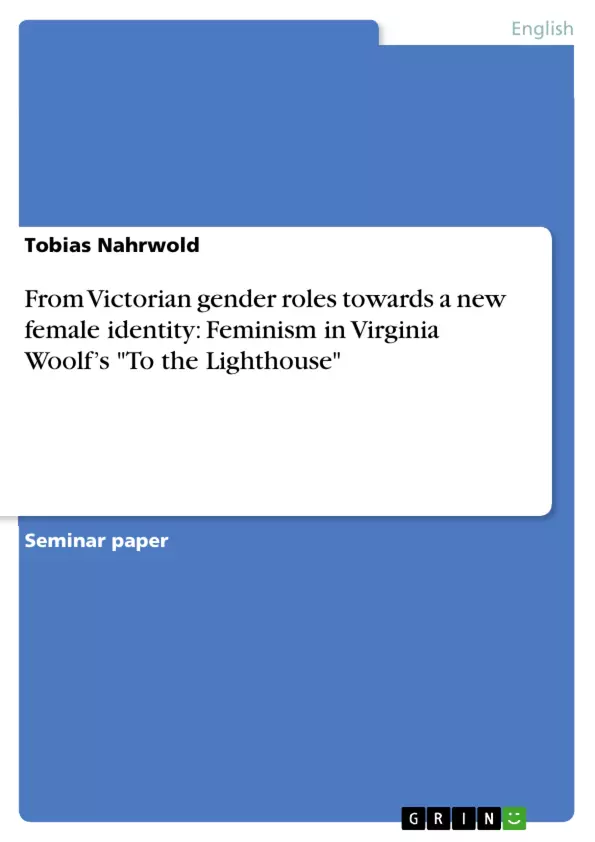In my term paper, I will firstly discuss traditional Victorian gender roles. I will begin with a description of Virginia Woolf’s family. Subsequently, Mrs. and Mr. Ramsay's characters are outlined, and I will show that Virginia’s parents served as their archetypes. In the next step I will illustrate that Lily Briscoe, although she wants to dissociate from the Ramsays, tries to come to terms with the family and seeks to take on their positive characteristics. To conclude, I will argue that Virginia’s family resembles the Ramsays very much.
By writing To the Lighthouse, Woolf wanted to liberate herself from the consequences of her mother’s constrictive household 'Angel' role. Woolf needed to understand and respect her mother and her father’s callous behaviour to create a new identity for herself and for every woman of her generation. Arisen from the time of feminist movement, To the Lighthouse can still enlighten psychological processes on the family level in today’s society.
Table of Contents
- Introduction
- Traditional Victorian Gender Roles
- The Stephen Family
- The Angel in the House: Mrs. Ramsay
- The Victorian Patriarch: Mr. Ramsay
- Lily Briscoe: Coming to Terms with Mrs. and Mr. Ramsay
- Conclusion: Woolf's Liberation from Her Mother and a New Female Identity
Objectives and Key Themes
This term paper aims to analyze Virginia Woolf's To the Lighthouse through the lens of Victorian gender roles. It examines how Woolf, drawing on her own family experiences, explores traditional gender expectations and their impact on women's lives. The paper particularly focuses on the portrayal of Mrs. Ramsay as the "Angel in the House" and how she navigates the constraints of her role, while contrasting her with the independent character of Lily Briscoe.
- Victorian Gender Roles
- The "Angel in the House" and Its Impact on Women
- Feminist Themes in Woolf's Writing
- The Role of Family and Personal Experience in Woolf's Work
- The Search for a New Female Identity
Chapter Summaries
The introduction sets the context for the analysis by highlighting Woolf's status as a significant feminist writer and situating the novel within the Victorian and Edwardian social structures. It also outlines the paper's structure, focusing on examining traditional gender roles, the portrayal of the Ramsay family as a model of Victorian values, and the complexities of Lily Briscoe's relationship with the family. The chapter on "Traditional Victorian Gender Roles" explores the Stephen family as a case study of Victorian values, with particular emphasis on the tragic consequences of sexual abuse. It further introduces the concept of the "Angel in the House," highlighting the expectations and constraints associated with the ideal of a subservient, self-sacrificing wife.
Chapter 2.2, "The Angel in the House: Mrs. Ramsay," delves deeper into this figure, analyzing how Mrs. Ramsay embodies the characteristics of the "Angel." The chapter explores her unwavering dedication to her husband and family, her emphasis on maintaining a traditional household, and her efforts to uphold conventional societal norms, particularly regarding marriage and procreation. It also contrasts her with the independent spirit of Lily Briscoe, setting the stage for a comparative exploration of female agency and self-discovery.
Keywords
The main keywords and focus topics of the text include Victorian gender roles, the "Angel in the House," feminist literature, Virginia Woolf, To the Lighthouse, family dynamics, female identity, self-discovery, and societal expectations. The paper explores how Woolf uses her novel to critique traditional gender roles, highlighting the struggles of women within a patriarchal society and their search for a new, more fulfilling identity.
- Quote paper
- Tobias Nahrwold (Author), 2005, From Victorian gender roles towards a new female identity: Feminism in Virginia Woolf’s "To the Lighthouse", Munich, GRIN Verlag, https://www.grin.com/document/59554



